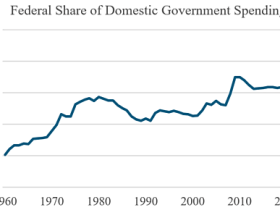Jeffrey A. Singer
According to news reports, Health and Human Services Secretary Robert F. Kennedy Jr. may release new US dietary guidelines before the end of the month.
HHS and the US Department of Agriculture have collaborated on issuing US dietary guidelines since 1980. That year, they used a “food wheel” as a tool to help the public understand and remember the information. They changed it to the now-discredited “food pyramid” in 1992.
As Cato’s Terence Kealey and journalist Nina Teicholz have highlighted, the food pyramid—which places grains at the bottom and fats and oils at the top—is more scientifically accurate if flipped upside down. Teicholz and others blame the 1992 guidelines for the sharp rise in obesity, diabetes, and other nutrition-related health issues. This disaster resulted from a mix of government bureaucrats authorized to interpret “the science” and special interest groups with ideological or economic goals.
Reports suggest that the new guidelines will encourage people to eat foods such as highly saturated fats, which most health professionals have previously considered unhealthy, but Secretary Kennedy believes promote good health. Many nutritional scientists and dieticians believe there is no credible evidence that increasing dietary saturated fat improves health outcomes. And while most critics of the food pyramid contend that the grain industry influenced the 1992 guidelines, critics of the purported 2025 guidelines allege that the meat industry is behind the saturated fat recommendations.
Different parts of the food industry have been lobbying federal nutrition policymakers for decades. The question isn’t whether nutrition science should evolve—it should—but whether government guidelines can ever reflect honest scientific debate when industries are lobbying from all sides.
Reports also suggest that the new guidelines could provide more details about the role that ultra-processed foods should have in Americans’ diet. However, as Terence Kealey, Bautista Vivanco, and I wrote here, the science in this area remains unsettled:
Which ingredients in which ultra-processed foods cause which chronic illnesses?
Some recent studies link specific ingredients in ultra-processed foods to certain illnesses, although this field of study is still in its early stages. While ultra-processed foods are often discussed as a category, researchers are beginning to isolate specific ingredients or additives that may contribute to health risks. However, many findings derive from animal studies or observational human studies, which cannot establish causality. Additionally, different ingredients appear in varying amounts across different ultra-processed foods. The dosage, frequency, and individual susceptibility vary significantly. It’s often challenging to isolate the effects of individual ingredients from the matrix of ultra-processed foods, which typically contain multiple risk factors (e.g., salt, fat, sugar, additives).
Studies indicate that even experts find it challenging to classify foods according to the Nova system consistently. For instance, various evaluators have classified plain yogurt as minimally processed, processed, or ultra-processed because they use unclear criteria. The Nova classification categorizes many fortified or enriched foods as ultra-processed, even baby formula.
If the COVID-19 pandemic taught us anything, it’s that science is not a fixed set of facts—it’s a process, constantly evolving as new evidence emerges. Our understanding changes and improves over time. When a government agency issues declarations based on its leaders’ consensus—or worse, on one person’s ideology—it wields an outsized and often harmful influence over civil society.
History also shows that government agencies are often susceptible to political and special interest pressures.
Returning again to the blog post I wrote with Kealey and Vivanco:
In a free society, there is a legitimate role for government in public health, as our colleague Michael Cannon explains. It is appropriate for the government to engage in public health policy, specifically in areas where the actions of some may threaten the lives and safety of others. All too often, government-directed research and policy today focus on personal health issues, which individuals can assess and manage independently, consulting experts as needed. We know all too well that when a public health agency issues opinions on personal health matters, it effectively becomes a mandate, disclaimers aside.
Unfortunately, many policymakers today have misinterpreted the term “public health” to refer to the health of any individual in the public. That doesn’t change the fact that one’s dietary choices are matters of personal health. These are matters that autonomous adults should be able to seek advice on from experts they select, who, like them, should be free from government influence.
One can reasonably expect the forthcoming dietary guidelines to spark significant controversy, with criticism coming from various directions. These arguments should be taking place among clinical researchers and practitioners, not involving or including government bureaucrats. The government should get out of the dietary guideline business and leave the discussion to scientists, doctors, and patients.
Science should inform dietary choices, not dictate them—and the federal government has no business deciding what Americans should eat.






